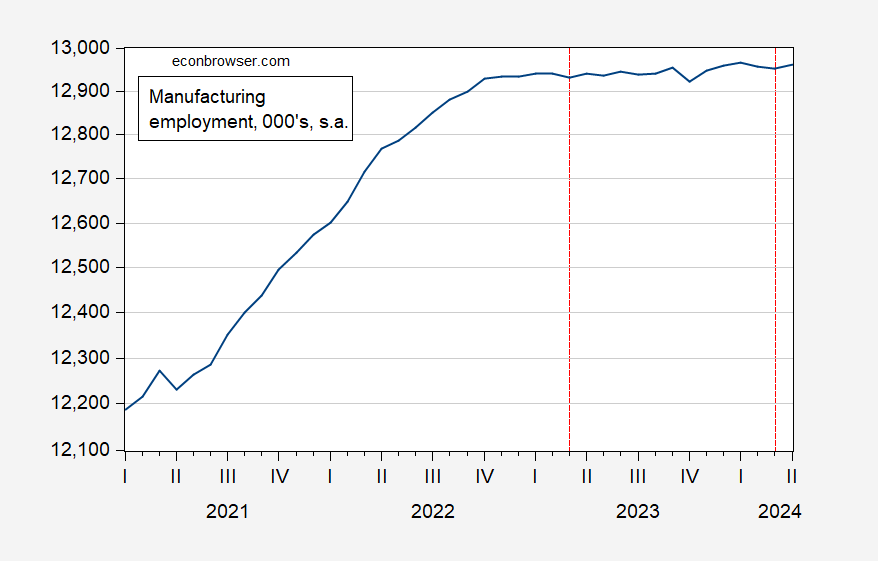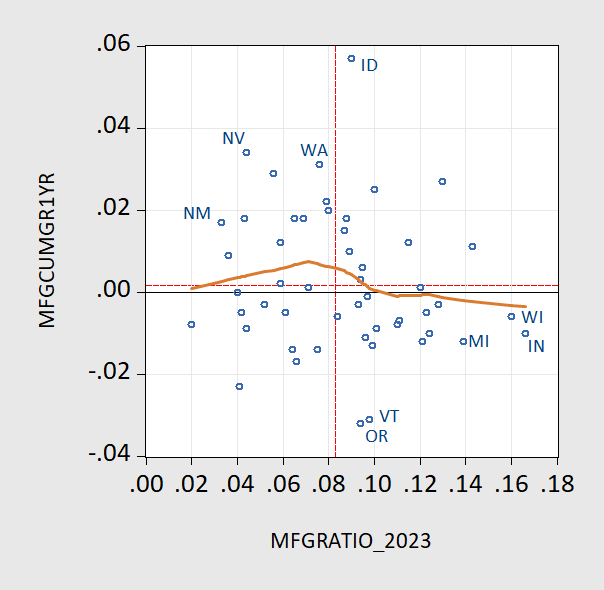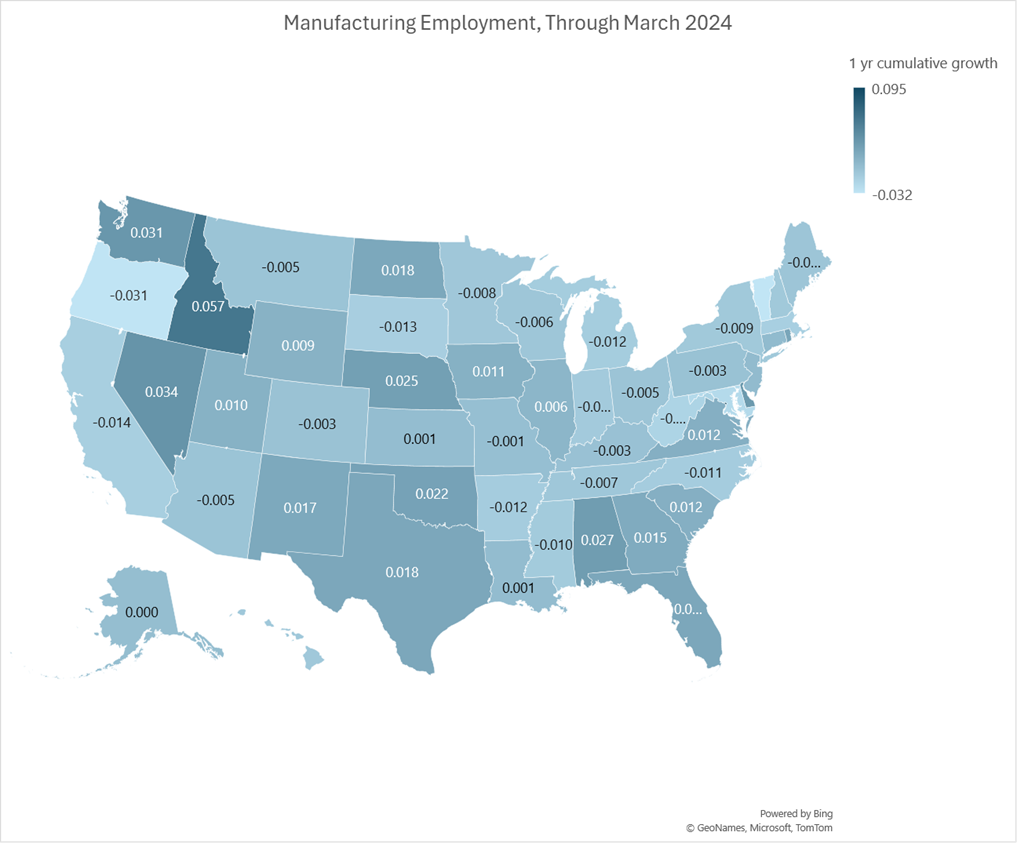Manufacturing employment is up relative to 3 years ago. Why so much dissatisfaction?
Figure 1: Employment in manufacturing, 000’s, s.a. (blue). Source: BLS.
Year-on-year through March, manufacturing employment is up 1.6% (log terms). Real wages are up as well, although only recouping 2020M11 levels recently (but exceeding pre-pandemic levels), while hours are down vis-a-vis peak 2022M10 levels.
Figure 2: Manufacturing hourly earnings in 2023$ (blue, left scale), and aggregate hours worked in manufacturing (tan, right scale), both for production and nonsupervisory workers. Real wage calculated using chained CPI seasonally adjusted by author using X-13. Source: BLS, and author’s calculations.
While the erosion of real wages during 2022-23 might explain some of the glum, I suspect another part is that manufacturing employment growth is not always located where manufacturing was concentrated before. While this could probably be seen at the county level, I’m going to examine the state level. Figure 3 displays year-on-year manufacturing employment growth by state versus manufacturing employment share a year prior.
Figure 3: Manufacturing employment y/y growth through March 2024 versus manufacturing share of nonfarm payroll employment in March 2023. Nearest neighbor fit (window=0.6) (tan line). Washington DC omitted. Red dashed lines at national averages. Source BLS, and author’s calculations.
Note that manufacturing intensive states like WI, MI, and IN have experience reductions in manufacturing employment, while those with little manufacturing (NM, NV, and to lesser extent WA) have rapid increases.
This of course is an ongoing process, where manufacturing has been moving from the Great Lakes region to the South and elsewhere. However, I think it’s of interest to consider this process in a period when manufacturing employment has been relatively constant, and yet there’s been a redistribution of employment.
Addendum, May 13, 2024:
Map of y/y manufacturing employment growth, through March:
Source: BLS and author’s calculations.



https://fred.stlouisfed.org/series/MANEMP
Even before COVID manufacturing employment was falling in 2019. Trump’s stupid trade war may be one reason.
Gee, pgl, I was looking at that chart before I saw your comment. You have to look pretty hard to find the “trade war” effect in the data which was a slow linear growth from the beginning of 2011 with a plateau the last year of Obama’s reign and a sharp increase the first year of Trump’s.
But all of that is irrelevant to the perception that the US manufacturing growth is fairly insignificant for almost 2 years despite the constant touting of Bidenomics and hardly higher than the end of 2019. Perhaps Biden’s handlers made a mistake setting expectations too high with their “it’s coming” campaign. Given population growth since 2019, manufacturing employment is barely keeping pace.
Then there is the issue of what is being manufactured. Beyond the electronics and chemicals (oil industry?) the rest is not all that impressive.
https://tsapps.nist.gov/publication/get_pdf.cfm?pub_id=956879 (some interesting graphics) Figure 2.4 shows manufacturing as percent of GDP has stayed in a relatively narrow range despite manufacturing employment dropping significantly during that period (automation?).
So, maybe manufacturing employment was the wrong bell for Biden to ring.
Well Mr Magoo. That trade war started in mid 2018. Come on dude…could you please stop embarrassing your mom
Always worth a look over a longer period, for context:
https://fred.stlouisfed.org/graph/?g=1nUCC
The Great Recession dramatically worsened a long stretch of factory job loss. We were recovering from Great-Recession-induced losses when Covid struck.
Real factory wages were massively inflated by Covid – mostly due to composition, I recall – and gave up those gains as normalcy returned. Real factory wages are roughly on trend now, and the trend us upward.
In the long run, manufacturing jobs are all dead. Robots, AI and 3D-printing will make sure that making things will require almost no human effort.
Ivan: Yup. But just like fossil fuels, it’ll take some time.
The good news is that if capitalism works we will get all these manufactured products for a fraction of what they cost today. The bad news is that capitalism doesn’t work.
Ivan: Well, that’s why we have a mixed market economy, not unbridled (yet) capitalism.
“Dissatisfaction” may be a response to opportunity. Factory workers are better positioned than most to organize and to demand compensation gains when profits are high. Profits during the period of rapid inflation were high, so it’s time.
In addition, the UAW gave up a big chunk of compensation in response to threats of job loss during and after the Great Recession. When auto makers got back in the black, nobody invited the UWA in for a chat about wage increases. That, I hear, is the cause of some dissatisfaction.
Lindsey Graham jumped the shark a long time ago. Now he just wants to annihilate brown people:
https://www.thedailybeast.com/sen-lindsey-graham-suggests-nuking-gaza-calls-hiroshima-the-right-decision
In Lindsey’s world, there are some children it’s OK to kill.
Well he did cuddle up with McCain pretending to be the Beach Boys with “bomb. bomb, bomb, bomb Iran”. Yea Little Lindsey is one racist POS.